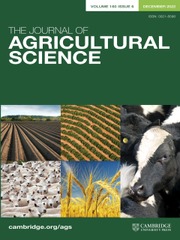Article contents
The effect of cultural and environmental factors on potato seed tuber morphology and subsequent sprout and stem development
Published online by Cambridge University Press: 01 March 2001
Abstract
Seed crops of the variety Estima were grown in each of 2 years using two planting dates, two harvest dates, two plant densities and two irrigation regimes to produce seed tubers which had experienced different cultural and environmental conditions. The effects of these treatments on tuber characteristics, sprout production and stem development in the ware crop were then determined in subsequent experiments using storage regimes of 3 and 10 °C. Time of planting the seed crop affected numbers of eyes, sprouts and above ground stems in the subsequent ware crop because environmental conditions around the time of tuber initiation appeared to alter tuber shape. Cooler, wetter conditions in the 7 days after tuber initiation were associated with tubers which were longer, heavier and had more eyes, sprouts and above ground stems. In contrast, the time of harvesting the seed crop did not affect tuber shape or numbers of above ground stems and there was no interaction with tuber size. The density of the seed crop had no effect on any character measured and irrigation well after tuber initiation did not affect tuber shape, numbers of sprouts or numbers of stems. Seed production treatments, which resulted in earlier dormancy break, were associated with tubers that produced more sprouts and above ground stems, in contrast to the conventional understanding of apical dominance. Storage at 3 °C gave fewer sprouts, a lower proportion of eyes with sprouts and fewer stems than storage at 10 °C. The major effects on stem production appear to result from environmental conditions at the time of tuber initiation of the seed crop and sprouting temperature.
Information
- Type
- Research Article
- Information
- Copyright
- 2001 Cambridge University Press
- 10
- Cited by

